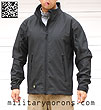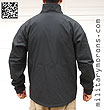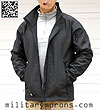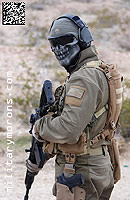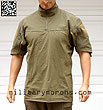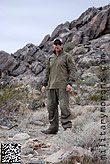Non-Insulated Soft Shells Page 1
Page 2 Page 3 Page
4
As a sizing reference: I'm 5'7", 155 lbs (yeah, I'm a little guy), medium build (BDU top medium/regular, BDU pant medium/short), waist 32", chest 43". Keep this in mind when you read my comments with respect to sizing, so you have an idea of how the garments featured below will fit on you. ALL garments in these pages are size Medium, unless stated otherwise.
TO VIEW FULL SIZE IMAGES: USERNAME and PASSWORD are both "mm"
| 9/2/10 - The Explorer Jacket is a new soft shell jacket from TAD (Triple Aught Design), and is a departure from their Stealth Hoodie line, as it doesn't have a hood, and is designed to be a non 'tactical' looking jacket that won't attract undue attention in public. For those who have been wanting a TAD Gear Soft Shell jacket without a hood, this would be it. While originally designed as a soft shell aimed at concealed carry for Law Enforcement, the Explorer isn't limited to that use.
Here's a summary of the features on the Explorer Jacket, size Medium shown, in D.F. (Dark Field) Gray:
Observations/Notes - Like most of TAD's current soft shell jackets, the Rhinoskin material used on the Explorer is waterproof (not water resistant); crossing over into hard shell realm. The Rhinoskin fabric has a softer hand than the last Rhinoskin garment I had (the Gen 2 Stealth Hoodie) and definitely has improved breathability. While the Explorer does have the tricot lining material, I put it in the non-insulated soft shell category instead of the insulated soft shell category because the lining material is there for comfort rather than to provide warmth/insulation. The Explorer is not a cold weather shell, and will need a mid layer for chillier temperatures. It does provide a small measure of warmth from trapped body heat, but not that much as it's more of a wind-breaker/rain jacket. When the weather heats up a bit, or when moving, the tricot lining does a very good job of keeping the inside of the jacket comfortable against the skin. The texture can be compared to putting a t-shirt on a hot leather car seat on a hot day - it'll help prevent you from sticking to it when you sweat. While the fit is more boxy and roomy than TAD's Stealth Hoodies, it's not a baggy jacket. I'm a 'medium' build, and am able to conceal a compat-sized pistol and a couple of spare mags under the jacket without very obvious printing. Folks with body shapes or builds different from mine will have different results, of course. A full sized handgun would show a bulge at the waist, at least on me, and would require a looser/baggier fit to hide. Since the fabric is uninsulated, I found the Explorer quite 'stuffable' in a backpack, which made it great for wearing it on cool mornings and stowing it in my bag in the warmer afternoons.
|
Arc'teryx LEAF Sphinx Halfshell
(Note: username and password are both 'mm' to view full size images)
| 2/26/11 - The Sphinx Halfshell is another new offering from the LEAF (Law Enforcement and Armed Forces) division of Arc'teryx, and is part of LEAF's new Armour Compatible Layering system. Also named after a legendary hybrid creature, the Sphinx is a 1/4-zip, non-insulated pullover hybrid combat shirt/jacket designed for use under armour in inclement weather. It uses two different weights of soft shell material in its construction to provide both freedom of movement and protection against the elements. The Sphinx also incorporates Arc'teryx's 'Roll-and-Stow' sleeve system that enables the user to convert the sleeve configuration on the go from long to short during periods of intense physical activity.
Note - I've already received several emails asking about the above skull mask. I hand-painted it on a Massif neck gaiter and tried to duplicate the MM skull logo/graphic on my T-shirt that was designed by Andrew Bawidamann Armour Compatible Layering - Arc'teryx's armour-compatible garments are designed to work as part of a synergistic system that includes body armour and gear as part of the layering system. By including armour as part of the system, Arc'teryx created a series of products to work in conjunction with the gear, that increases comfort, performance and versatility across a wide range of activities and environments. Two of the most distinctive features is the use of hybrid construction (different weights of soft shell fabric, or soft and hard shell textile combinations), and their Roll-and-Stow sleeve system. The hybrid construction of the Sphinx provides weather-resistant protection for the user, while the stowable sleeves allow a greater range of operating temperatures for the jacket and aids in cooling the user down after hard extertion without having to take off the jacket and armour. The rolled up sleeve store underneath the shoulder pockets, leaving nothing exposed to snag. Material - The Sphinx utilizes two weights of soft shell fabric in its construction (Crocodile shown here): Tweave® Durastretch 520e for the Shoulder yoke and sleeves - 520e is a technical, 4-way stretch woven with 91% nylon and 9% lycra spandex. Durastretch is a durable, abrasion resistant, water and wind resistant, low-bulk, breathable fabric with excellent stretch and recovery properties. The Multi-directional (4-way) permanent-stretch spandex has 100% memory for shape retention. The Tweave Duratretch 520e used for the Sphinx is not laminated to a lining fabric - it is a single layer material. It is designed as a breathable shell material for wind and moisture resistance rather than an insulating material. This means that it can be used in warmer temperatures, and is very packable. It is treated with a DWR (durable water repellant). This is the same fabric used for the Arc'teryx Combat jacket and pants. Note that the DWR (water repellant treatment) will have to be 'renewed' after some time, with a spray-on or wash-in treatment. I prefer the spray-on treatments. Tweave® Durastretch LT 536n for the Torso and Under Arms - This material is lighter and stretchier than the 520e for freedom of movement, and is very similar to the LT 520e (lighter weight version of 520e) used on the yoke, shoulders and sleeves of the Chimera Shirt LS. I originally thought that it was the same material, but after reading the specs and taking a closer look, I can see that it's slightly different. It is also a technical 4-way stretch woven with 84% nylon and 16% lycra spandex. It is a durable, abrasion resistant, water and wind resistant, low-bulk, breathable fabric with excellent stretch and recovery properties. The Multi-directional (4-way) permanent-stretch spandex has 100% memory for shape retention. Here's a summary of the features on the Sphinx Half-shell Combat Jacket, size medium in Crocodile shown (also available in Crye MultiCam):
Sizing, fit etc - The Sphinx is sized like the Gryphon, which feels like it fits exactly like the Arc'teryx Combat Jacket on me. This is what Arc'Teryx refers to as 'athletic patterning', which means 'more form fitting but unrestrictive' - maybe with a bit more room around the shoulders and chest with a slimmer waist. It's not at all tight on me, nor baggy either. The torso tapers towards the waist, and the Tweave fabric is stretchy enough to make donning it over the head easy, and has low enough bulk to be tucked into the pants. Once on, the Sphinx is very comfortable and non-restrictive. There's ample room in the sleeves, as well. The gusseted underarms prevent the cuffs from riding up when lifting the arms over the head. General notes and observations - The Sphinx Halfshell falls between the combat 'shirt' and 'jacket' category - in between the Chimera Shirt LS and the Combat Jacket. The Chimera Shirt LS is a light weight performance shirt designed for warm/hot and wet conditions while the Combat Jacket is a techinical alternative to the standard BDU top in cooler and inclement weather. The Sphinx is very much like the Combat Jacket when it comes to the sleeves and shoulders, but optimized for wear under armour with the lighter weight soft shell fabric on the torso, pull-over configuration and the capability to roll up the sleeves. So, in a nutshell, I'd categorize the Sphinx as an inclement weather BDU top/combat jacket replacement specifically for use in conjunction with armour, for use by itself or as a mid layer. When would it be used? Arc'Teryx knows that no melt/no drip is a requirement for some conditions, and that the Sphinx does not fall under that category. While the nylon/cotton based systems are cheap, relatively durable and mostly no-melt/no-drip, they get wet and stay wet under adverse weather conditions, for which the Sphinx was designed primarily for. The Sphinx is intended to be used as a combat uniform replacement in most areas other than the summer time in hot deserts and on operations in vehicles without good fire suppression systems. Since the fabric holds very little water and dries faster than a regular BDU top, the Sphinx is well suited for operations in and around water. It is also undergoing niche user testing for SDV and HALO/HAHO inserts. The Sphinx is similar to the Gryphon Halfshell with its hybrid construction and roll and stow sleeve system. The Gryphon offers better protection from the rain with its water-proof Gore-Tex shell material on the sleeves, yoke and hood, while the Sphinx offers slightly less water resistance but more breathability. The lack of features on the torso, and the breathable soft-shell fabric make the Sphinx very comfortable under armour or a pack. The heavier soft shell fabric is placed on areas of the jacket that are exposed, not covered by armour and subject to more wear. With the sleeves worn down, the Sphinx offers similar protection to that of the Combat Jacket, but with a lighter weight and more breathable torso. The Sphinx is best worn over a t-shirt or very thin base layer, and can also serve a a mid-layer under a jacket. It's less bulky than a BDU top, and packs down to a smaller package than a regular BDU jacket. With the sleeves rolled up, the Sphinx can be worn in warmer temperatures than the Combat Jacket, and also allow more ventilation/cooling under exertion.
The roll and stow sleeve system is a simplified version of what's on the Gryphon, and also works very well. The sleeve is just rolled up and stuffed inside the shoulder, rather than in a separate compartment. There's nothing left to flop around, snag or come loose. I found that I don't have to roll up the sleeve tightly; in fact it's better to just fold it up a few times so it's flat, rather than in a roll, as it lays flatter under the shoulder. The under arm loop doesn't have to be tight; just snug enough to keep the folded-up sleeve secure inside the shoulder. I actually like the adjustable arm strap of the Sphinx vs. the fixed length one on the Gryphon, as some guys with big arms may find the fixed loops a bit tight. The shoulder pockets remain fully accessible and functional with the sleeves up or down, and the heat-shrink tubing on the zipper pulls makes them easy to grab. The weather was comfortably cool (50's to low 60's) when I wore the Sphinx over a t-shirt out in the desert, and it also drizzled. I didn't need to roll up the sleeves except to get used to doing it, and seeing what the difference in temperature felt like. It does make a significant difference, as when the sleeves are stowed, the pit zips are usually left completely unzipped. With all the zippers closed, it does provide a little bit of warmth from trapped body heat. We had weird weather that day - going from pretty chilly to drizzle to sun later on in the afternoon, and the Sphinx worked well the entire time. When it was colder, I wore it under the Atom AF jacket. Drizzle falling on the Sphinx evaporated soon after. We had some rainy weather lately and I wore it out in the rain just to see what would happen. As expected, it did get wet, but didn't feel waterlogged and dried quickly once indoors. As with the Gryphon, the Sphinx Halfshell is well suited to wet and slightly cooler weather, where it will have a distinct advantage over a standard BDU top or non-weather resistant garment.
|
782 Gear Velocity Softshell 1/4 Zip Pullover
| 6/19/11 - The Velocity Softshell 1/4 Zip Pullover from 782 Gear is an ultra-light, non-insulated softshell top for protection from wind and water. It can be used as an inclement/cool-weather replacement for a combat shirt when worn with armour. 782 Gear is based in Fall River, MA with remote offices in WA and NOVA, and was started from the inspiration of those who put their lives on the line each day in the defense of this nation's freedom. Their products are developed for such professionals, who demand comfort and performance from their clothing and equipment. The name '782 gear' is what Marines called their individual field equipment as they had to sign for it on the standard Marine Corps Form 782, which is no longer in use. Old traditions die hard, which brings up 782 Gear's slogan: 'Tradition Meets Innovation'. 782 Gear uses the latest in materials to produce their gear, which is not surprising since 782 Gear is a division of Duro Textiles, LLC, which is one of the country's largest dyers, printers, finishers and distributors ot textile products. Duro produces all of Crye's MultiCam fabrics. Duro, in turn, is owned by Patriarch Partners LLC (Lynn Tilton's company), who is credited with turning MD Helicopters around. Description - The Velocity Softshell 1/4 Zip Pullover is a light-weight pullover that can be used as a wind/rain jacket by itself or as an inclement weather replacement for a combat shirt. 782'sPerimeter Series garments are designed for protection against the weather. The BAC 1/4 Zip is a long-sleeved jersey, instead of the more 'traditional' combat shirt with BDU-type sleeves and pockets. Materials - The Velocity is made up of two fabrics: Schoeller® NanoSphere® treated 2-way stretch shell and Tweave DURASTRETCH® 4-way stretch. It's currently available only in Crye MultiCam. 2-way stretch shell - The velocity uses the Delta fabric from Schneider mills. It's a 40D Nylon 2-way stretch soft shell which is IR treated and has a soft hand ideal for soft shell jackets, and weighs approximately 5 oz per square yard. It's laminated to a moisture wicking knit, which allows for quick drying comfort. The face of the Delta fabric is Schoeller® NanoSphere® treated. The NanoSphere DWR coating is very water resistant and slick to the touch, even though the fabric is textured. Water beads up on the surface and it doesn't wet out when soaked for long periods. The nanoparticles in the NanoSphere finish form a fine structure on the textile surface. Water or substances such as oil or ketchup simply run off the NanoSphere surface which is naturally self-cleaning, and any residue can easily be rinsed off with a little water. The NanoSphere coating has a high level of abrasion resistance, and the protective function is retained even with heavy-duty use. The jacket therefore requires less frequent washings at lower temperatures (wash resistance is up to 100 washings). No fabric softener or dryer sheets are to be used.
Tweave Durastretch - The side stretch panels are made light weight Tweave Durastretch fabric. It is a technical 4-way stretch woven with 84% nylon and 16% lycra spandex. It is a durable, abrasion resistant, water and wind resistant, low-bulk, breathable fabric with excellent stretch and recovery properties. The Multi-directional (4-way) permanent-stretch spandex has 100% memory for shape retention. The bottom of the back and the wrist cuffs also incorporate the Tweave material. Here's a summary of the features on the Velocity Soft-shell 1/4 Zip Pullover, size medium in Crye MultiCam shown:
Sizing, fit etc - The Velocity is comfortably sized - not too much excess fabric but still easy to don and doff. The deep front zipepr certainly helps in this regard. Some pullovers are too tight and a bear to take on and off, but the Velocity slips on and off easily. There's ample room in the shoulders and back for full range of motion. It can be worn tucked in or out, but I'd normally wear it out. General notes and observations - One of the most interesting things about the Velocity Soft Shell is the Delta fabric. The outside face as a textured, completely matte finish with a very fine ripstop pattern visible in the weave. The fabric certainly feel durable. The lining fabric consists of a diamond grid pattern, and this is what helps make the Delta fabric more comfortable when sweating than an unlined fabric. It reduces that hot, stick-to-the-skin feeling. I found the Delta fabric to be very water resistant, almost water proof. Left in the sink for a few hours, the water eventually overcame the DWR, and soaked into the face fabric, but didn't penetrate through to the other side. It also dried very quickly and didn't hold water. Looking at the test report for the Delta fabric, the air permeability is zero, which means that this fabric is completely windproof. MVT is in the 'low' range, which means that it's not very breathable. The Velocity was designed for high warmth/weight ratio, and that's how it accomplishes it - by trapping the body heat inside it. For these reasons, I'd consider the Velocity most suitable for cool weather use only; not for hot or humid climates.
This proved to be true when I wore the Velocity in cool weather - it actually kept me quite warm, considering that it's a non-insulated top. Wind was no challenge. It was compact enough to wear under my motorcycle mesh jacket, which I wore on cold morning commutes with the Velocity underneath. I also used it on some cold evenings along the coast, where it stopped the cold air short. My one reservation in its use is during times of extertion, when you start sweating. Even though it has the long zipper in front for ventilation, it might get too stuffy due to the Delta fabric trapping all the body heat inside. Of course, this depends on the conditions under which it's being used; how cold it is, and weather a thin baselayer is being used. I'd estimate that the low 60's is the upper limit for wearing the Velocity top - any warmer than that and you'll get too warm. That's good news for you cold-climate folks. For its packability and light weight, it's warmer than you'd think, especially if you're not static. The one thing I'd like to see added is velcro adjustment at the cuffs. While the Tweave fabric is stretchy, it's not that stretchy and the cuffs are a bit loose around my girly wrists. Pit zips on this garment might not be a bad thing either, if more ventilation is needed. You just have to know what conditions are most suitable for using the Velocity Soft Shell in, and it'll perform as expected.
|
ATTENTION! PLEASE DO NOT LINK DIRECTLY TO MY IMAGES
-
IT RESULTS IN MY BANDWIDTH ALLOCATIONS BEING EXCEEDED,
AND MY PAGES GO DOWN. THANKS!
/ . PLEASE
OBSERVE AND RESPECT OUR COPYRIGHT! . /
©opyright by MilitaryMorons.com. All Rights Reserved. Reproduction, Duplication,
Distribution Strictly Prohibited.
Unless mentioned otherwise, content and images are the
property of militarymorons.com and are not in the public domain.
They are not to be used without
permission. Please Contact
me for permission to use any images or content herein.

